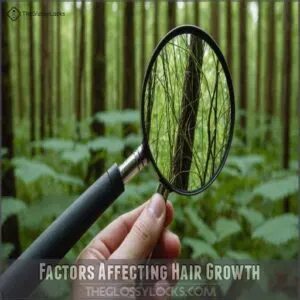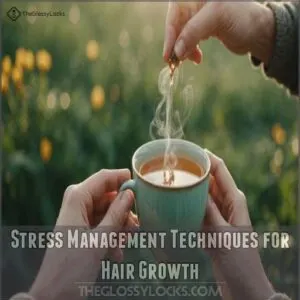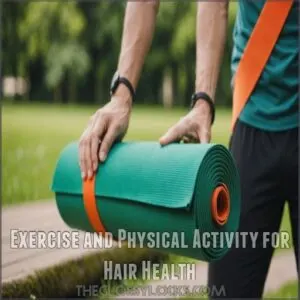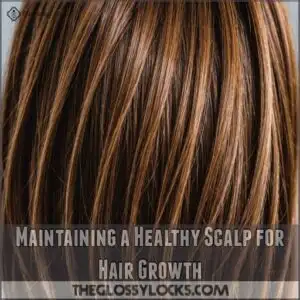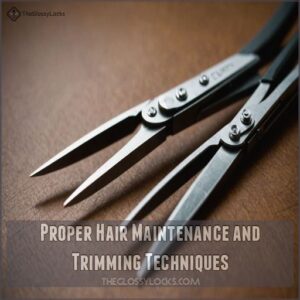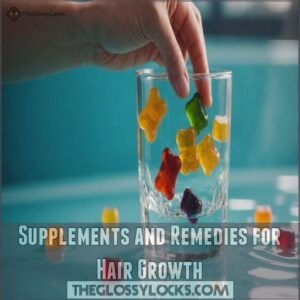This site is supported by our readers. We may earn a commission, at no cost to you, if you purchase through links.
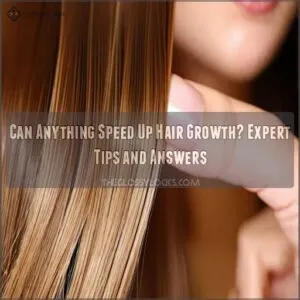 While there’s no magic potion to speed up hair growth, you can certainly help your hair along its natural path.
While there’s no magic potion to speed up hair growth, you can certainly help your hair along its natural path.
You might start by ensuring you eat a well-balanced diet rich in vitamins and protein, which are essential for hair health.
Reducing stress and getting enough sleep are vital too, as they’re like the secret sauce for strong, healthy hair.
Also, scalp care matters—think of it as the fertile ground where your hair grows.
Consider using supplements like biotin or vitamin D and trying gentle scalp massages.
Curious about more hair-healthy habits? We’ve got plenty of tips up our sleeve!
Table Of Contents
- Key Takeaways
- Factors Affecting Hair Growth
- Promoting Hair Growth Through Lifestyle Changes
- Effective Hair Care Practices for Growth
- Supplements and Remedies for Hair Growth
- Frequently Asked Questions (FAQs)
- Why do you want to make your hair grow faster?
- Can I make my hair grow faster overnight?
- How to grow hair faster & longer?
- Does hair grow faster if it’s healthy?
- Can you wash your hair every day?
- Does weather affect hair growth?
- How long does it take to speed up hair growth?
- Does your hair grow slower as it gets longer?
- Can anything make my hair grow faster?
- How can I drastically speed up my hair growth?
- What helps with immediate hair growth?
- How can I stimulate my hair follicles for hair growth?
- How do hormones influence hair growth speed?
- Can stress levels impact hair growth rates?
- Does hair grow faster with frequent trims?
- What role does sleep quality play in hair growth?
- How does water intake affect hair growth?
- Conclusion
Key Takeaways
- You can’t magically speed up hair growth overnight, but you can significantly improve its health and potentially its growth rate.
- A balanced diet rich in protein, vitamins (like biotin and D), and minerals is crucial for healthy hair growth.
- Managing stress, getting enough sleep, and regular exercise boost blood flow to the scalp, stimulating hair follicles.
- Gentle scalp massages, minimizing heat styling, and using gentle hair products contribute to a healthier scalp and potentially faster growth.
Factors Affecting Hair Growth
Hair growth isn’t just about patience; factors like nutrition, medical conditions, and even your daily habits can speed or slow the process.
Understanding these can give you a surprising edge in terms of having a healthy, flowing mane.
Nutritional Support for Hair Growth
Eating a balanced diet is like giving your hair roots the best foundation.
Hair growth speed is influenced by genetics, age, and overall health, with the average rate being 0.5 to 1.7 centimeters per month as detailed in average hair growth in a month. Hair growth speed hinges on what you eat, so load up on protein-rich foods like fish and beans.
For an extra boost, consider adding hair growth supplements to your routine.
Not getting enough protein can lead to deficiencies that slow your hair growth rate.
Consider supplements if your diet’s off track, ensuring your mane stays lush and vibrant.
Role of Vitamins and Minerals
After nourishing your body with a balanced diet, don’t overlook vitamins and minerals.
They’re like the secret sauce in your hair growth recipe.
Deficiencies in micronutrients like Biotin, Vitamin D, and Zinc can slow down your hair growth speed.
Think of them as little helpers, ensuring your hair’s journey from root to tip is smooth and swift.
Importance of Adequate Protein Intake
So, you’ve nailed vitamins and minerals for healthy hair? Great! Now, let’s talk protein.
Think of it as the building block for strong, shiny strands.
Protein deficiency can lead to hair loss, so make sure you’re getting enough.
A balanced diet helps, but protein supplements might give your hair an extra boost.
They can improve your hair health.
Remember, a healthy diet and sufficient protein intake are key for strong, healthy hair growth.
Effect of Medical Conditions on Hair Growth
If you’re consuming enough protein yet still battling hair loss, medical conditions might be the sneaky culprits.
Stress-induced hair loss, like telogen effluvium, can also play a significant role in disrupting your hair growth cycle, as seen in cases of hair loss due to stress treatment.
Hormonal imbalances, thyroid disorders, autoimmune diseases, and scalp infections can disrupt your hair growth cycle. Understanding the four stages of the hair growth cycle stages explained can help you identify what might be causing issues with your hair growth.
Even medications can mess with your hair growth stages. It’s a bit like trying to water a garden with a leaky hose—frustratingly ineffective.
Promoting Hair Growth Through Lifestyle Changes
You can boost hair growth by incorporating lifestyle changes like managing stress, staying active, and ensuring you get enough sleep.
These habits improve overall health and create an environment where your hair can thrive.
Stress Management Techniques for Hair Growth
Stress can throw a wrench in your hair growth plans.
Embrace relaxation techniques like mindfulness and meditation to combat stress, promoting healthier hair.
Incorporate deep breathing exercises and yoga to soothe tension.
These practices quell anxiety but may also reduce hair shedding and support hair growth.
Take control with these simple methods to keep your hair journey on track.
Exercise and Physical Activity for Hair Health
Understanding your hair type through systems like the Andre Walker’s Curl Typing System, while crucial for proper hair care, won’t directly impact hair growth. While dealing with stress can help reduce hair loss, don’t overlook exercise’s impact on hair health.
Moving your body boosts blood flow, stimulating your scalp and encouraging hair growth.
Give these a try:
- Yoga: Poses promoting circulation.
- Cardio: Enhances overall blood flow.
- Scalp exercises: Gentle massage for thicker hair.
Importance of Adequate Sleep and Rest
Getting enough sleep is like watering a plant – essential for growth, including your hair.
Sleep deprivation can disrupt your sleep cycle, leading to hair loss.
Using sleep hair growth products, such as those found in sleep hair growth aids, can support your hair’s natural growth processes.
Quality rest boosts growth by optimizing your body’s natural processes.
Picture your hair happily growing, thriving on the benefits of ample rest.
| Key Factor | Impact on Hair Growth |
|---|---|
| Sleep Quality | Enhances growth |
| Sleep Cycle | Regulates hair processes |
| Sleep Duration | Supports faster growth |
| Stress Reduction | Prevents hair loss |
| Energy Renewal | Optimizes growth rate |
Maintaining a Healthy Scalp for Hair Growth
Think of your scalp like a garden; it needs care to flourish.
Cleanse regularly to maintain scalp health and avoid issues leading to hair thinning.
Balance hair hygiene without over-washing.
Scalp massages boost circulation, aiding hair growth promotion.
Opt for hair product choices that support your scalp’s needs, contributing to faster hair growth and hair loss prevention.
Effective Hair Care Practices for Growth
You can make a big difference in your hair’s health and growth with simple, everyday care.
This includes limiting heat styling, choosing gentle products, and protecting your hair from sun and environmental damage.
Minimizing Heat Exposure and Chemical Treatments
Minimizing Heat Exposure and Chemical Treatments (Effective Hair Care Practices for Growth)
To boost hair growth, reducing heat exposure and chemical treatments is key.
Heat styling damage can weaken hair, so explore cold styling techniques and chemical-free alternatives.
Understanding the signs of heat damage repair can also help you take proactive steps to prevent further damage.
Hair product safety is essential—scan labels for harsh chemicals.
Adopting natural hair care methods helps minimize hair damage, allowing your locks to thrive naturally without depending on excessive heat or chemical interventions.
Proper Hair Maintenance and Trimming Techniques
Imagine this: your hair’s like a garden needing regular trims to flourish.
Trimming cuts off split ends, improving hair growth rate by reducing breakage.
Using a hair growth serum like those found in the hair growth products online can also boost your hair care routine.
Tailor your hair maintenance routine to your hair type, using the right brush type to prevent damage.
Remember, a consistent hair care routine is a simple yet powerful step towards healthier, longer locks.
Supplements and Remedies for Hair Growth
In terms of speeding up hair growth, supplements and remedies like biotin, vitamin D, and caffeine offer potential benefits.
By incorporating options like rosemary oil, lavender oil, and scalp massages into your routine, you may find your hair growing healthier and possibly faster.
Biotin and Vitamin D for Hair Growth
Keeping your locks healthy involves more than just hair care.
A balanced diet rich in nutrients like protein, vitamins, and minerals is crucial for maintaining overall health, including boosting metabolism and calorie burn during the hair growth cycle. Biotin and vitamin D are essential players in your hair’s growth saga.
Lack these, and you might see more strands in your hairbrush.
Consider supplements if your diet’s lacking.
They’re your body’s backstage crew, ensuring every hair shines on.
Make hair health a priority!
Caffeine as a Hair Growth Promoter
While vitamins like biotin boost hair, caffeine steps in as a surprising ally.
It helps hair follicles enter the anagen phase, promoting growth.
Use caffeine shampoos to enhance thickness and reduce hair loss.
Consider these benefits:
- Caffeine for Hair Loss: Slows shedding.
- Caffeine vs. Minoxidil: Supports similar growth.
- Caffeine Shampoo Benefits: Thickens strands.
- Caffeine and Hair Growth Studies: Shows promising results.
Rosemary Oil and Lavender Oil for Hair Growth
Caffeine might boost your hair’s health, but don’t overlook rosemary and lavender oils.
Known for their soothing aromas, they’re also potential hair growth champions.
Studies suggest rosemary oil can be as effective as minoxidil, a common hair growth treatment.
Lavender oil, meanwhile, supports growth by delaying hair fall.
Mix them in DIY blends, but exercise essential oil safety.
Scalp Massage for Stimulating Hair Follicles
Regular scalp massage might just be your secret weapon for stronger, healthier hair.
It’s thought to boost blood flow to your hair follicles, giving them the nutrients they need to thrive.
Here’s how to do it:
- Use your fingertips, not your nails.
- Gently massage your scalp in circular motions for a few minutes daily.
- Experiment with different techniques to find what works best for you. You might even see an improvement in your hair growth rate!
Frequently Asked Questions (FAQs)
Why do you want to make your hair grow faster?
You might want faster hair growth to change your style, recover from a bad haircut, or improve hair health after damage.
Understanding hair growth processes and effective treatments can empower you to achieve desired results.
Can I make my hair grow faster overnight?
Growing hair overnight is like expecting a tree to sprout in a day—patience is key.
Hair growth involves many factors, like diet and care, and there are no shortcuts for instant results.
How to grow hair faster & longer?
Balance your diet with biotin, vitamin D, and protein, while avoiding heat styling and harsh treatments.
Caffeine-infused shampoos and scalp massages might boost growth.
Remember, patience is key—hair grows about half an inch monthly.
Does hair grow faster if it’s healthy?
Isn’t it great when things just work better when they’re healthy?
Keeping your hair in top condition certainly helps it grow faster.
Proper nutrition, gentle care, and avoiding harsh treatments improve growth potential.
Healthy hair, happy you!
Can you wash your hair every day?
Daily washing isn’t harmful for everyone, but it can strip natural oils.
Listen to your hair; if it feels dry or brittle, wash less often.
Experiment to find what works best for you.
Does weather affect hair growth?
Think of hair growth as a garden that changes with the seasons.
Warmer weather might boost growth by improving blood flow to hair follicles, but it’s more anecdotal than proven.
Consistent care and nutrition remain key regardless of the weather.
How long does it take to speed up hair growth?
Speeding up hair growth isn’t overnight magic—expect at least three to six months of consistent effort for results.
Focus on balanced nutrition, topical treatments, and gentle hair care practices to gradually encourage healthier, quicker-growing hair.
Does your hair grow slower as it gets longer?
Your hair doesn’t grow slower as it gets longer.
Growth rate depends on genetics and health, not length.
Hair grows in cycles, so while older strands might reach a stopping point, new ones keep growing as usual.
Can anything make my hair grow faster?
Hair growth seems slow, but some methods may help.
Maintain a healthy diet rich in vitamins, like Biotin and Iron.
Use caffeine-infused products.
Massage your scalp.
Limit heat styling.
And consult professionals if needed.
How can I drastically speed up my hair growth?
Think of your hair as a plant—it thrives on nutrients.
Nourish it with a balanced diet, minimize stress, and use growth-stimulating oils like rosemary.
Healthy habits and consistent care can naturally nudge your hair to flourish.
What helps with immediate hair growth?
Boost hair growth with strategies like balanced nutrition including biotin and protein, scalp stimulation with gentle brushing techniques for healthy hair growth, and topical treatments like minoxidil, and essential oils.
Scalp massages increase blood flow, while products with caffeine might add thickness.
Consult a doctor for persistent concerns.
How can I stimulate my hair follicles for hair growth?
Picture tiny sprouts awakening! A healthy diet, gentle scalp massage, and avoiding harsh chemicals can help stimulate those follicles. Patience, friend; growth takes time.
How do hormones influence hair growth speed?
Hormones play a big role in hair growth speed.
Androgens can either stimulate or slow hair growth depending on the individual’s sensitivity.
During pregnancy, increased estrogen extends the growth phase, often leading to thicker hair.
Can stress levels impact hair growth rates?
Stress affects hair growth.
High stress can push hair follicles into a resting phase, making hair fall out faster.
It’s like traffic jamming up your scalp’s growth lanes, leading to more hair loss over time.
Does hair grow faster with frequent trims?
Frequent trims don’t actually speed up hair growth, but they do help by removing split ends, preventing breakage.
Split ends can make your hair look thinner and less healthy.
Keeping your hair healthy can make it seem like it’s growing faster because it’s not breaking off.
What role does sleep quality play in hair growth?
Good sleep quality impacts hair growth by regulating hormones and reducing stress, which helps your hair’s anagen phase last longer.
Consider it the natural conditioner that nurtures your follicle’s health and supports lush, resilient hair growth.
How does water intake affect hair growth?
Drinking enough water can boost hair growth by keeping your scalp hydrated and healthy. Proper hydration helps maintain a healthy moisture balance within the hair and scalp, reducing brittleness and promoting hair growth, as seen in the science behind hydrated hair.
Around 75% of hair follicles are water, so staying well-hydrated can be like nurturing a garden, promoting stronger and fuller hair.
Conclusion
While there’s no instant miracle to speed up hair growth, combining good nutrition with lifestyle adjustments can certainly help your locks thrive.
From managing stress to maintaining a healthy scalp, these strategies support hair wellness.
Though no single solution guarantees rapid results, embracing a holistic approach provides the best chance for improvement.
So, take time to nourish your body and mind, and watch as your hair gradually reflects your efforts and care.

